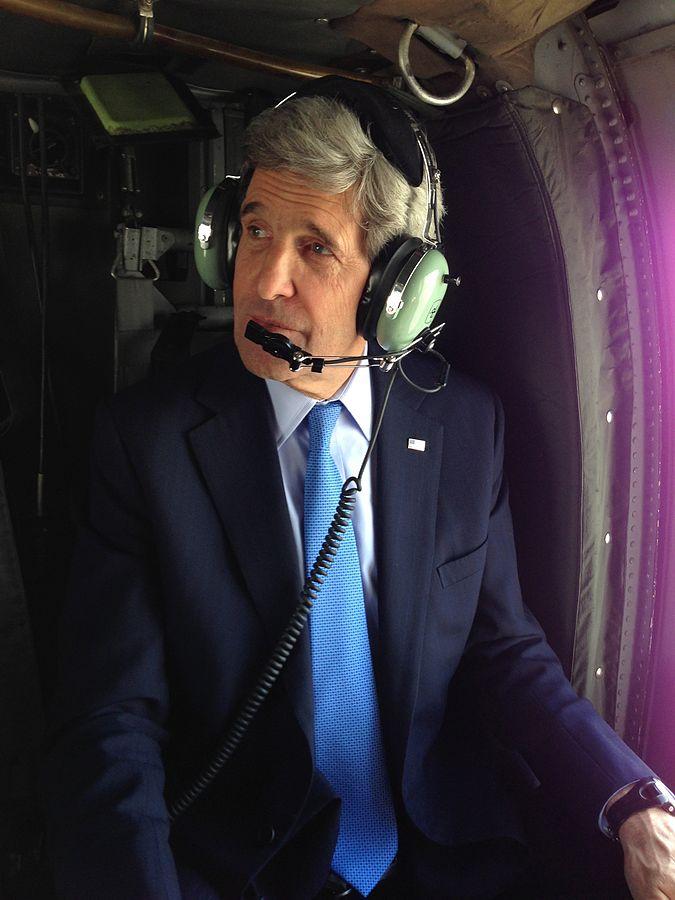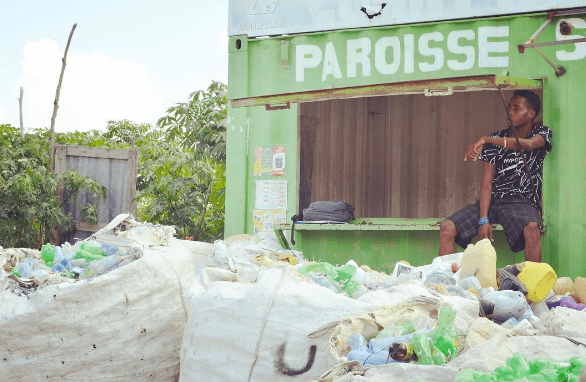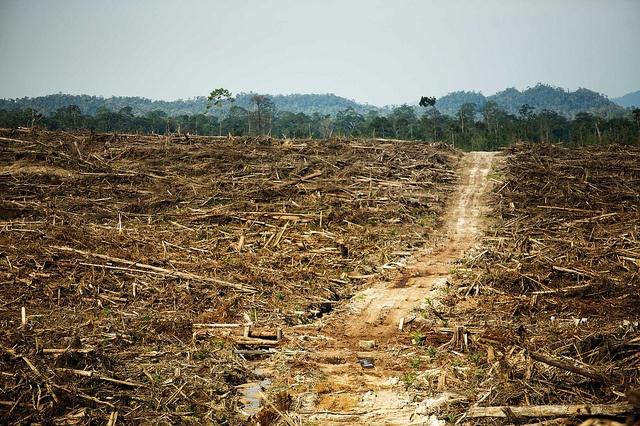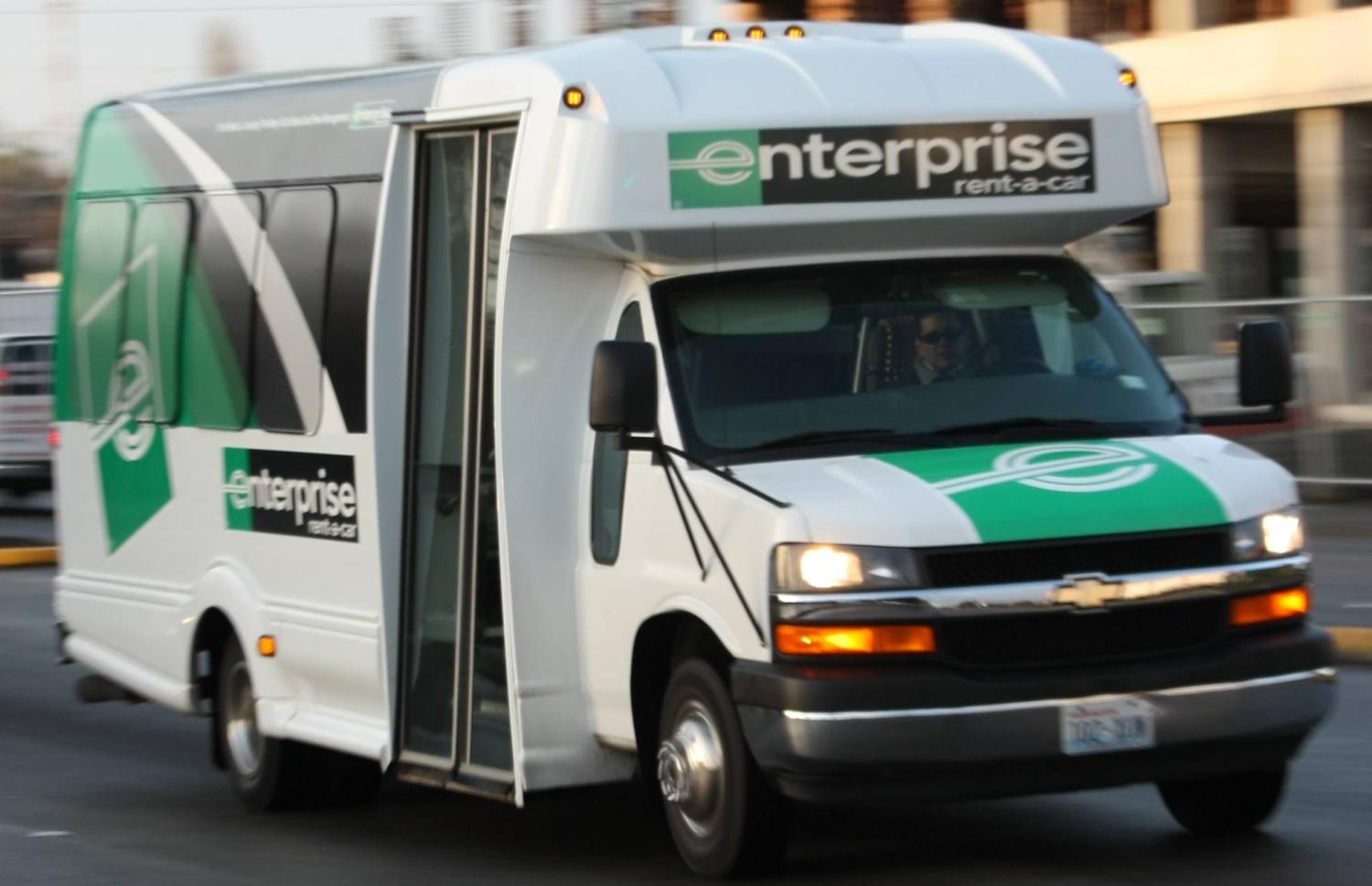Unraveling the Climate Consequences of a Trump Presidency


Dean Scott, the senior climate change reporter for Bloomberg, moderated a panel discussion this weekend at the 2016 conference of the Society of Environmental Journalists. The topic at hand was the upcoming U.S. election and what it means for climate change policy, particularly if Donald Trump wins the presidency.
You might think that his position on climate change is “typical” or just “more of the same” from the GOP. But, like so many other issues, Trump’s surreal candidacy is “quite a departure” for the Republican party. In his 24 years of reporting, Scott says he has "never witnessed an election cycle where a candidate fails to release any formal policy position papers."
Instead, Scott says, Trump’s position on climate change must be interpreted through tweets and off-the-cuff statements, such as: “I believe in clean air, immaculate air, but I don’t believe in climate change.”
Politics after Paris
Trump says he will “cancel” the Paris Agreement, giving no consideration to the impact such an attempt will have on America's standing in the global community. But, of course, Trump has little (or no) understanding of the agreement. It cannot simply be “canceled."
In a sense, the Paris treaty anticipates the likes of Donald Trump. Heather Zichal, former energy and climate advisor to President Barack Obama and senior fellow for the Atlantic Council's Global Energy Center, says a formal withdrawal from the treaty “isn’t an issue,” even with a Trump presidency. It involves a lengthy process and “would severely damage the U.S. in the global community." Not exactly “making America great again.”
What Trump can do, however, is to delay agreement implementation, underfund U.S. commitments, and “cause mischief."
“I want to be clear,” Zichal says, “I don’t think we’ve ever faced a bigger threat in terms of policy and climate action.” Donald Trump plays “fast and loose with the rules” and is “disconnected with reality.”
Earth to Trump
Donald Trump’s climate and energy policy is “hard to decipher,” says James Connaughton, CEO of Nautilus Data Technologies and former energy aid to President George W. Bush.
Broadly speaking, Connaughton says, Trump proposes “ramping up” all sources of U.S. energy production. He claims he will put coal workers back to work.
CEOs of large utilities are well aware they are in a “moment of transition,” especially the coal industry. It is a “fantasy that coal is coming back,” Connaughton says, and a “false narrative.”
We waste our time and betray the reality of the economic circumstances by “glamorizing” the coal worker for “what they’ve done for the country the past century,” Connaughton says. I believe that assessment is correct. Coal helped build America, for better and worse, but its dominant role in the economy is fading.
Its undoing isn’t so much due to liberal environmental activism as it is fracking natural gas and the rapidly declining cost of wind and solar power. The reality has changed for coal. Instead of making empty, uneducated claims of bringing coal jobs back to coal country, the discussion should center around real solutions for coal communities.
So far, Donald Trump hasn’t shown an understanding or concern for coal communities beyond uttering empty promises he can’t keep.
Congress should do its job
By the beginning of President Obama’s second term, it was clear that seeking a legislative approach to climate policy was futile. Congress “refused to act,” recalls Zichal, a former Obama adviser. The administration tried working with Congress, but their recalcitrance pushed Obama to seek executive action. If Obama can use executive action to influence climate policy, then what’s to stop Trump from doing the same?
For a CEO of a coal or utility company, that’s a very important question. The better route is using the legislative process, but a dysfunctional Congress makes it impossible.
“The senate should do its job,” Connaughton says. The lack of clear policy signals from Congress frustrates coal and energy CEOs, who need a sign on how to invest and rebuild a fleet of aging power plants.
Welcome to the Anthropocene
The direction is clear if the path still a little opaque. The energy economy is in transition. Global warming really is a thing, Sen. James Inhofe’s snowball antics on the senate floor notwithstanding. The impacts of a changing climate are already here, “detected and attributed." We have pushed our climate beyond the norms of the Holocene, the only epoch humans have ever known. Until now. Welcome to the Anthropocene.
The question now is what we intend to do about it; “how far, how fast, how much much will it cost,” Connaughton says. We may not be aiming far enough or moving fast enough. And we may be stuck in a false narrative about the cost, but it will be “hard to stop the pathway we are already on.”
The underlying fear is that Donald Trump might give it a go. And there is much at stake.
Editor's note: This post first appeared in Globalwarmingisreal.com
Image credit: Flickr/Jamelle Bouie
John Kerry, the Environmental Secretary of State


As John Kerry's tenure as the 68th U.S. Secretary of State winds down, his legacy is open to debate, as is the case with his most recent predecessors.
While Hillary Clinton is oft criticized for being too cautious during her time heading the State Department, there is little argument that Kerry’s tenure has been consequential. Whether you agree with his politics or not, it is clear that the former Massachusetts senator and 2004 presidential candidate forged ahead in doing what he thinks is right.
Of course, unlike Clinton, he has no eye on a higher political prize. The two main U.S. political parties no longer give a candidate a second chance if they lose an election; many say Kerry blew his chance 12 years ago. But he can still find further redemption, just as he has the past four years.
As he seeks the next chapter, Kerry has an opportunity to build on a record unprecedented in U.S. history. After all, no other secretary of state used the platform to take action on the global environment quite like Kerry, from his work on last year’s COP21 climate talks in Paris to the former Navy Lieutenant’s advocacy to improve the world’s stewardship of its oceans.
Despite now being in his seventies, Kerry should be able to make a significant impact within the private sector after he leaves the State Department in January. Any company that wants to take serious action to become a more responsible organization on both the environment and human rights (which clearly are intertwined) should have asked for his resume yesterday. Even with only a few months left on the job, however, Kerry is still keeping his eye on current tasks.
And one significant agenda item is on the schedule this week. As global leaders meet in Dubai to update the 1987 Montreal protocols in order to limit production and emissions of hydrofluorocarbons (HFCs), Kerry is urging governments, the private sector and NGOs to find areas of common ground so the momentum from last year’s Paris talks does not stall. Kerry’s advocacy, and work behind the scenes, is one big reason why the U.S. agreed to reduce its total greenhouse gas emissions by as much as 28 percent below 2005 levels by 2025. This commitment from the world’s largest consumer of energy was unthinkable just a few years ago.
Opponents of Kerry’s agenda question why the nation’s top diplomat has spent so much time on environmental problems in light of other pressing challenges. The flip side to that argument is that, since Kerry is not padding his resume, he can focus on issues that will spark controversy and also generate results.
The evidence suggests climate change is already causing instability, from the threats of social unrest due to drought in the Middle East to the damages suffered here at home after Hurricane Sandy in 2012. But these problems should induce more than just hand-wringing: they can also spark new economic opportunities, whether they come in the form of new investments in the clean energy industry or new innovations in the transportation sector.
Furthermore, if businesses are going to survive in the long term, they need a resilient planet that can still harvest the products they need to feed and supply the world, as well as provide long-term value for their shareholders. Hence, more action is needed to ensure the world's oceans are still viable sources of food and its forests are managed properly to provide timber and paper.
A company that brings Kerry on board will show it is serious about sustainable development and changing how it conducts business – provided, of course, he is hired to be a change agent and not a figurehead.
Image credit: State Department/Wiki Commons
Hydrogen Economy Gets Real: Renewable Power for Rail Transportation


Just a few years ago the sustainable hydrogen economy seemed a long way off, but things are moving along at a rapid clip. In the latest development, French mobility company Alstom says it is ready to market zero-emissions, hydrogen-powered passenger trains in Europe. The new trains could hit the rails by the end of next year.
That may not be such great news for the environment if Alstom plans to get all that hydrogen from natural gas, which is the conventional way to do it. However, we're guessing the company is already looking to provide its clients with hydrogen from renewable sources.
The trouble with hydrogen
Hydrogen is a zero-emission fuel, but the natural gas angle pretty much kills the tailpipe advantages. That's especially true in the U.S., where the impacts of natural gas fracking include air pollution and impacts on water resources.
Earthquakes are another side effect of fracking, say some scientists. Though the drilling operation itself has been linked to seismic activity only in rare cases, the disposal of wastewater from oil and gas drilling, including fracking, has made formerly quiet areas into earthquake hotspots.
Methane leaks along the natural gas supply chain, from wellhead to storage and pipelines, is another critical issue in terms of both global warming and local hazards.
In addition to environmental impacts, researchers are also beginning to amass evidence of public health impacts in areas that have experienced the recent fracking boom. (Fracking is short for hydraulic fracturing, a formerly "unconventional" oil and gas drilling method with relatively limited application until the Bush administration provided it with an exemption from federal water protection rules.)
All in all, depending on natural gas for the hydrogen supply chain of the future is not a good idea.
Sustainable hydrogen for transportation
Alstom seems to have the jump on that problem. Europe is a promising staging area to launch hydrogen-powered trains because the EU has already begun to invest in sustainable hydrogen production.
The emphasis is on using renewable energy, such as wind energy or tidal energy, to power an electrocatalytic operation that strips hydrogen from water.
In effect, renewable hydrogen production is a form of energy storage. Instead of being used in combustion engines, hydrogen can be stored and used in mobile fuel cells for electric vehicles and other transportation systems, as well as stationary fuel cells that generate electricity for buildings.
Moreover, last year Alstom hooked up with the company Hydrogenics to do this:
"Hydrogenics ... a leading developer and manufacturer of hydrogen generation and hydrogen-based power modules, today announced that it has signed a 10 year exclusive agreement to supply Alstom Transport with hydrogen fuel cell systems for Regional Commuter Trains in Europe," the company said in a press release.
That's significant because Hydrogenics specializes in wind-to-hydrogen production.
Earlier this summer, Hydrogenics and other partners launched the first megawatt-scale energy storage project in Asia, at the Lam Takhong Wind Turbine Generation Project in Thailand. An electrolyzer powered by wind energy will produce hydrogen from water during off-peak hours. The stored hydrogen will then be used to provide fuel for a fuel cell system.
The fuel cell system will be kicked into gear as needed to provide electricity for the Learning Center, an energy-neutral project of the Electricity Generation Authority of Thailand.
So, it seems a pretty safe bet that Alstom's pitch for hydrogen-powered transportation also includes a renewable energy angle.
Hydrogen-powered trains
That finally brings us to Alstom's new hydrogen-powered trains.
Alstom has its sights set on the market for train systems in Europe that are not yet electrified. These systems run on diesel, and many of them are not likely to be electrified any time soon.
Alstom's Michael Wittwer observes:
"Despite numerous electrification projects in several countries, a significant part of Europe’s rail network will remain non-electrified in the long term. In many countries, the number of diesel trains in circulation is still high – more than 4,000 cars in Germany, for instance."
Alstom's solution, which it introduced at the InnoTrans railway transportation trade show last week, is dubbed Coradia iLint.
The company already signed letters of intent with several transportation systems in Germany to bring the Coradia online.
The new train is actually based on Alstom's Coradia Lint 54, which runs on diesel. The diesel version has a strong track record, with more than 2,400 trains in service globally. Alstom appears to be relying on this record to pitch the new zero-emissions version.
To sweeten the pot, Alstom is packaging the train as a turnkey solution that includes maintenance and the entire hydrogen infrastructure, presumably through its partnership with Hydrogenics.
As for how it works, the heart of the system is a fuel cell stack and hydrogen storage tanks. As the train requires electricity, the hydrogen combines with ambient oxygen to generate a charge. The only emission is water.
The system is also supported by lithium-ion battery packs. This auxiliary system is combined with regenerative braking to reduce the consumption of hydrogen.
The primary market consists of existing train routes that rely on diesel. The new train may also have some appeal as a replacement for aging electric systems that are due for an overhaul, especially where aesthetic concerns provide an extra motivation to eliminate overhead wires.
Hydrogen transportation for the U.S. -- and more
Compared to Europe, the U.S. has been a little slow off the starting gate when it comes to hydrogen transportation.
However, the Obama administration launched a series of hydrogen programs ranging from foundational research to support for local initiatives.
One recently announced Energy Department program is called the H2@scale concept. This initiative aims at "wide-scale deployment of hydrogen to deeply decarbonize the U.S. electricity generation, transportation, and industrial sectors," with a focus on renewable hydrogen.
The initiative also looks at deploying heat from nuclear reactors and other industrial processes to produce fossil-free hydrogen.
Hydrogen-powered trains are also on the horizon in America. Texas-based BSNF Railway, for example, is working on a hybrid fuel cell train for urban applications, in partnership with the Engineer Research and Development Center of the U.S. Army Corps of Engineers.
California lent a kickstart to the hydrogen fuel cell electric vehicle market, and last year it commissioned a report on the feasibility of hydrogen freight trains.
Image courtesy of Alstom
Dunkin’ Donuts Still Serves Up Foam Cups Despite Years of Promises


Six years ago Dunkin’ Brands, the parent company of Dunkin’ Donuts and Baskin-Robbins, promised its stakeholders that finding an alternative to foam cups was the company’s “No. 1 sustainability priority.”
But most Dunkin’ locations are still serving up java in cups made from polystyrene (more commonly known as Styrofoam, a registered trademark of Dow Chemical), Emily Cohn of Business Insider reported this week. Furthermore, even though other fast food chains have transitioned away from foam packaging over stakeholders’ concerns about environmental impact, Dunkin' has made it clear it sees no urgency in finding an alternative.
The company announced yet again in 2014 that it would end the use of polystyrene after research suggested the packaging material could be linked to cancer. Those messages were repeated again last year, but Dunkin’ is carrying on as if it is business as usual.
Other food companies switched to alternatives such as paper cups. Although paper is an imperfect solution, it's an incremental improvement over a material that, depending on the source cited, takes anywhere from several decades to several centuries to decompose. Food companies had long responded to those complaints by making their case that polystyrene was the most sanitary single-use option in which to serve food and beverages.
Some of Dunkin’s competitors, however, made the switch without causing angst within their consumer base. In the late 1980s, several environmental groups led the charge against McDonald’s for its use of foam packaging for hamburgers and other food products. The fast food giant eventually worked with the Environmental Defense Fund to find a solution, which is why your Big Macs are served in a cardboard box today. Back then, the polystyrene industry complained about the company’s 1990 decision to cease the use of foam packaging, and insisted a recycling system could fix that waste problem. But almost three decades later, polystyrene recycling still has not proven to be scalable or economically feasible.
And earlier this decade, after McDonald’s solved some of its then-doldrums by reinvigorating its coffee options – therefore increasing its consumption of Styrofoam cups – the company decided in 2013 to replace polystyrene with a paper-based alternative.
Of course, whether fast food companies use foam, paper or plant-based plastic, there is still the pesky challenge of waste diversion, as most of this material enters landfills instead of recycling centers. Do not expect this problem to change for the better any time soon, as the low cost of fossil fuels moved manufacturers to use virgin materials instead of recycled feedstock.
On that point, several years ago the veteran sustainability writer Marc Gunther made a behavioral economic argument for companies like Starbucks to change their pricing approach. Instead of knocking the price of a beverage by a dime or so for customers who bring their own cups, Gunther suggested that companies charge an extra for a single-use container. The price would be the same, Gunther insisted, but human psychology would nudge consumers to bring their own reusable container more often. Much like bans or fees on plastic shopping bags convinces more shoppers to bring their own bags to the supermarket, a different approach toward how we serve that morning coffee or afternoon decaf could start making a difference.
But for now, environmental groups are making the case that polystyrene has got to go.
Dunkin’ Brands has an opportunity to enact more change and persuade more food companies to take on similar policies. In recent years, the company moved toward sourcing only sustainable palm oil and humanely-produced meat and eggs. After a shareholder proposal urged the company to eliminate nanomaterials such as titanium dioxide, Dunkin' removed them from its products. The company also proved to be open to other waste reduction measures, such as a pilot program that used bio-digesters at a few locations. Taking a stand on single-use containers would prove to stakeholders that Dunkin’ Brands is serious about being a responsible corporate citizen.
Image credit: Mr.TinDC/Flickr
Clinton Global Initiative and Thread Bring Dignity to Haiti’s Plastic Bottle Collectors


An awful lot of fuss has been made about the relationships between the Clinton Global Initiative (CGI) and its donors. Whisper campaigns – and screaming campaigns – alleged all sorts of nefarious behavior resulting from donations to CGI and the Clinton Foundation. Although the evidence suggests Hillary Clinton’s role centers around glad-handing at most, the current chatter buries the good work the foundation has done since Clinton’s husband left the White House in 2001. From women’s empowerment to vaccines to tackling poverty, it is hard to argue that this organization has not been a force for economic empowerment and social change.
And speaking of enacting change, one of the foundation’s latest social enterprise projects involves one of the world’s poorest nations, Haiti, which is still recovering (if that is the correct word) from the devastating 2010 earthquake.
As is the case with much of Latin America and the Caribbean, trash collectors -- such as the pepenadores in Mexico or catadores in Brazil -- perform some of the most exhausting and low-paying work across the region. This is especially true in Haiti, where income opportunities are few and per capita income is $1,760 a year, according to the World Bank.
To that end, CGI announced a new Commitment to Action that seeks to help boost the working and living conditions of 300 Haitians who collect recyclables for money, 200 of whom are children, by giving them more educational opportunities and access to social services.
Thread, a social enterprise that sources plastic bottles from Haiti and Honduras and churns them into fabric manufactured in the U.S., is leading this effort. Thread and CGI are joined in this partnership by Timberland, HP and the NGO Team Tassy.
By the end of 2019, Thread expects to invest $300,000 in funds and services to finance healthcare services and a support network for these bottles collectors, as well as a field assessment of the program’s success and scalability. Thread says it hopes to repeat this model in regions across the world. Scale would depend on whether the company can score more corporate buyers for the recycled plastic, especially firms seeking a more closed-loop system in the drive to eliminate waste.
So far, Timberland committed this project by buying fabric made from collected bottles for use in some of its shoes and bags. HP will use some of the recycled material to manufacture its ink jet printer cartridges. In a publicly statement, Ian Rosenberger, Thread’s founder and CEO, said such investment is necessary as “the very bottom of the supply chain is where people are the most vulnerable.”
In its most recent annual report, Thread says it is already supporting 3,575 income opportunities and almost 300 jobs in the garbage collection and recycling industries across Haiti. During the reporting period ending in 2015, garbage collectors working with Thread collected over 440,000 pounds of plastic, most of which was shipped to the U.S. and blended with cotton to manufacture jersey, canvas and denim fabrics. That is a steep decline from 2013, when 660,000 pounds were collected – a decrease Thread attributes to low oil prices, which makes recycled materials far less price-competitive than virgin materials.
Nevertheless, Thread’s work with the support of CGI is critical to keep people employed and keep trash out of landfills and even oceans. Garment manufacturers and retailers that insist they want to do “good work” should take a look at Thread -- and social enterprises that share a similar model -- if they really want to make their clothes more socially and environmentally responsible.
Image credit: Thread/Instagram
Compensation awarded to Bangladeshi apparel workers


As Palm Oil Abuses Widen, WWF Releases Global Scorecard


Palm oil continues to leave behind a long record of environmental destruction and human rights abuses. The list includes widely-documented deforestation practices, along with the endemic air pollution across Southeast Asia that led to accusations of companies in Indonesia hiring mercenaries to take smog inspectors hostage.
To that end, a recent WWF scorecard that evaluates companies’ performance offers some hope and surprise to consumers. But the report also shows the industry has much work to do in proving it can be more sustainable and responsible.
The study evaluates 137 of the world’s largest and most recognizable companies. Scores are based on several factors, including membership in the Roundtable on Sustainable Palm Oil (RSPO), the level of transparency in operations and supply chains, and commitment to sourcing what WWF defines as sustainable palm oil. WWF researchers also looked at whether companies actually purchased palm oil from reliable and sustainable sources, or if they relied on purchasing sustainable palm oil certificates from organizations such as GreenPalm.
For consumers here in the U.S., the results are encouraging. Companies that received high marks from WWF include Walmart, McDonald’s, Colgate-Palmolive and Estée Lauder. Walmart, for example, has come far in the eyes of WWF since the first such survey in 2009. But while the world’s largest retailer is “leading the way,” there is still some room for improvement. The company largely relies on certificates and says it will not commit to buying only physical certified sustainable palm oil (CSPO) until 2025.
Other food producers and retailers, however, have a long way to go. And WWF asked customers and stakeholders to push these firms into action. The list includes Campbell Soup and Dunkin’ Brands, as well as the chain stores Kroger, Target, Costco and Safeway. Then there are the companies that earned a huge thumb’s down for not bothering to report at all, as in Hillshire Brands, Yum! Brands and one silent grocer that will surprise many: Whole Foods.
And worldwide, if words are met by deeds, then only three companies can really say they are change-makers within the global palm oil supply chain. The Australian snack manufacturer Arnott’s, the French multinational Danone and Italy’s confectionery Ferrero are lauded by WWF for using 100 percent segregated palm oil supplies for their portfolio of products.
Yet across Europe, which activists often blame for deforestation due to the region’s aggressive biofuels mandate, there are still too many companies, including large retailers, that either have tepid palm oil sourcing policies or did not respond to WWF’s survey at all.
The WWF report is a sobering reminder that despite the growing outcry against the global palm oil sector, the chances are high that abuses will increase rather than decline. Last week media reports revealed that the price of palm oil on commodities markets are at a five-month high as supplies cannot meet global demand. Hence palm oil producers are looking beyond the world’s two largest producers of this ingredient, Indonesia and Malaysia, to new markets in Africa and Latin America.
With half of the world’s processed food and personal care products containing palm oil, expect its impact on people and the planet to only become worse unless companies, civil society and governments can agree on a path to mitigate its widespread damage.
Image credit: Rainforest Action Network/Flickr
Why Enterprise Joined ALEC For a Hot Second -- Then Ditched


The powerful conservative lobbying organization ALEC is looking not-so-powerful these days. Some of its top corporate members have repudiated the group for its hardline policies on issues like climate change, gun control, local rights and the privatization of public land. In the latest development, the company Enterprise Rent-a-Car has joined the rush to the doors.
Enterprise is a top corporate sustainability leader, so its membership in ALEC (the American Legislative Exchange Council) may seem like an odd choice. However, the company says it had a rationale for contributing to the group.
The problem for ALEC is that Enterprise, and many other companies, have an even better reason to cut ties.
Why Enterprise joined ALEC
Enterprise was "outed" as an ALEC member by an article in the Guardian early last summer. The paper acted on a tip from the organization Center for Media and Democracy.
In an August 26 article, TriplePundit's Leon Kaye detailed the many ways in which ALEC policy positions are at odds with the company's culture. In a follow-up article on August 30, Kaye wrote:
"Despite the baggage that comes with being a paid ALEC member, Enterprise refuses to budge. When a TriplePundit writer called out the car-rental giant on Twitter, the company posted this response:"'Our work [with] ALEC is solely focused on fighting unfair car rental excise taxes on behalf of all car-sharing and rental customers.'”
Enterprise tried to make a rational case for fighting the car rental excise tax. As Kaye noted, municipalities have begun to use taxes on the hospitality industry to help make up for budget shortfalls. Typically, such taxes fall upon visitors, thus sparing local policymakers from the wrath of local voters.
(Note: Enterprise Rent-a-Car is one of three car rental companies under the Enterprise Holdings umbrella. The other two are Alamo and National.)
Outrage ensues over ALEC membership
Enterprise's defense was basically an attempt to compartmentalize. In the end, it failed miserably -- and quickly.
By Sept. 21, the Guardian was reporting that the "public outcry" over Enterprise's ALEC membership prompted the company to announce that it would drop its membership effective immediately.
The nut of the issue is ALEC's advocacy for policies that block strong action on climate change and other environmental issues -- issues that Enterprise claims are at the heart of its corporate culture.
Here's how a petition on act.climatetruth.org expressed it:
Tell Enterprise: Drive Away From ALEC!Enterprise: Live up to your own sustainability values by cutting all ties immediately with the American Legislative Exchange Council (ALEC), an extreme right-wing lobbying group that denies climate change and blocks climate action. It is hypocritical for you to make "green" commitments in public while funding ALEC in private.
Before Enterprise announced its decision to leave, ALEC attempted to steer public opinion over to its side.
One example is an article that appeared on Sept. 12 at the Daily Signal, a news organization run by the conservative think tank (and prominent ALEC supporter) The Heritage Foundation.
The ALEC climate change denial mindset is on full display in the article. As described by Daily Signal writer Kevin Mooney, the organization defends itself by claiming that it doesn't really take sides on the issue:
"ALEC actually hasn’t waded far into the debate over climate change, though it has made members aware of both sides, a spokesman told The Daily Signal."'Somehow our opposition to [the government’s renewable energy] mandates and subsidies has been conflated into climate change denial,' Bill Meierling, the organization’s vice president of public affairs, said in a brief interview last week."
Mooney cites another high-profile, ALEC-linked conservative source to back up the ALEC position:
"ALEC is the victim of 'identity politics,' said Sam Kazman, legal counsel to Competitive Enterprise Institute, a conservative Washington think tank.“'When a scientific controversy becomes the rallying cry for a consumer boycott campaign, you know you’re in the wonderland of identity politics,' Kazman told The Daily Signal in an email. 'ALEC is one fine group, and here’s hoping that their supporters are fruitful and multiply.'”
That argument presupposes that "both sides" carry equal weight.
However, climate change is not a matter of philosophical debate. It is a measurable phenomenon that is subject to the same principles of scientific investigation and analysis as any other.
On that score, clearly there is no "both sides" to the climate change "debate."
Why Enterprise left ALEC
Though the Heritage Foundation blames "liberal pressure groups" for Enterprise's decision, the stakes were actually much higher for the company's corporate values.
In a recent interview with Glass Door, Enterprise CEO Pamela Nicholson lead off with this observation:
"... I’ve seen firsthand how steady, effective leadership built on a solid foundation of culture and shared values attracts top talent and creates a successful business."
After noting Enterprise's 60-year history as a family-managed company, Nicholson emphasized that "consistency and continuity of leadership is an important part of our lasting success."
Enterprise codifies those principles into eight statements, based on values first articulated by founder Jack Taylor. Take a look at No. 6 on the list, and it's clear that ALEC did not stand a chance against that "liberal" pressure:
Great things happen when we listen...to our customers and to each other.Image (cropped): by Atomic Taco via flickr.com, creative commons license.
Toyota Plans to Run a Fuel Cell Car On Human Waste


In its home country, Toyota will utilize human waste to produce energy for its flagship fuel cell car, the Mirai.
The company linked up with a water processing plant in Fukuoka, Japan, to source sewage sludge for energy. The sludge, which would otherwise go to landfill, is converted into biogas with the help of microorganisms. This environmentally-friendly process creates a key element that is used in the car’s fuel cell to produce electricity.
Sixty percent of the resulting biogas is methane, and 40 percent carbon dioxide. Without getting too technical, by isolating the methane and combining it with water vapor, hydrogen gas is produced.
The hydrogen that is recovered eventually finds its way into a Mirai’s fuel tank. And electricity is produced when hydrogen is combined with oxygen in the vehicle’s fuel cell, which powers the car’s electric motor.
The typical way hydrogen is commercially produced is by extracting methane from natural gas. This means that while fuel cell vehicles are zero-emissions at the point of use, they're not necessarily, or even typically, fossil-fuel free. Conversely, processing sewage to produce hydrogen avoids the use of fossil fuels, while at the same time reducing landfill waste. And since sewage waste produces biogas anyway, harnessing this byproduct effectively means there is no environmental downside to producing hydrogen in this way.
The idea isn’t new, but the fact that Toyota is backing it is important, as the car company is one of only a few that has a fuel cell vehicle available to the public today. Though the auto industry has experimented with fuel cell vehicles for a long time, the ramp-up to adoption remains slow. This is in part because fuel cells continue to be an expensive technology but also because there are very few filling stations where you can pump hydrogen. It’s a bit of a “chicken-and-egg” problem.
By demonstrating the concept of turning sewage into fuel, Toyota’s program not only illustrates a sustainable way of producing hydrogen, but also points to a future where every city might be able to capitalize on what is a naturally-distributed means of production. After all, every sizable population center has a wastewater treatment plant.
Indeed, turning sewage waste into a transportation fuel is already happening in California. This, again, is important because in the United States, if fuel cell vehicles catch on, early adoption will certainly take place in California.
FuelCell Energy, Inc. ran a demonstration project extracting hydrogen from human waste in Fountain Valley, California, a suburb of Los Angeles. Here, hydrogen was not only produced as a transportation fuel, but also to generate electricity for industrial applications.
The plant was able to produce enough hydrogen -- 100 kilograms daily -- to power around 50 cars a day, Scientific American reported. That isn't many, but the project was designed as a proof of concept, not as a commercial operation. Scientific American detailed that commercial viability would kick in at around 600 kilograms a day. But the catch is: Though this would power 300 cars a day, at that level of supply, it actually outstripped demand as a transportation fuel.
Likewise, Toyota’s project in Fukuoka is a relatively small operation, only producing enough hydrogen to power 65 Mirai vehicles. However, the company thinks the process could be scaled up to power as many as 600 cars a day if all of the wastewater plant’s biogas was converted to hydrogen.
So, the big question is: Will fuel cell vehicles eventually catch on? Navigant Research projects global demand could reach 228,000 vehicles a year by 2024, including both cars and buses. Hydrogen from sewage waste would struggle to meet demand at that level of course. But imagine if all the world’s big cities treated sewage for hydrogen production; that would constitute a significant level of production from an otherwise waste product.
For now, getting behind the wheel of a Toyota Mirai in California will cost you $57,500 to buy, or $349 a month to lease. But the customer, happily, will receive three years of complimentary fuel -- good news if you happen to live close to one of the 40 hydrogen filling stations California plans to have by the end of 2016. No guarantees the hydrogen from those pumps comes from sewage waste though.
image courtesy of the author, taken at the 2014 San Francisco Auto Show
In Silicon Valley, Even a Vegan Food Company Can be a Unicorn


When we think of bad corporate behavior, we tend to assume the usual suspects: energy companies, as in Enron 15 years ago or ExxonMobil’s current SEC investigation; banks, thanks to the 2008–2009 financial crisis and the current Wells Fargo “fake accounts” scandal; or big conglomerates, such as Tyco, with business models we don’t really understand and CEOs who prey on oblivious investors.
Surely a food company that is on a mission to end animal torture, improve public health and save the environment would refrain from such shenanigans. But as last week’s Bloomberg investigation revealed, Hampton Creek and its founder and CEO, Josh Tetrick, have been accused of cooking the books, over-inflating data about products’ environmental footprint and, in the end, possibly defrauding investors.
And all of this was apparently done to boost the valuation of the company behind Just Mayo in yet another quest to become a Silicon Valley “unicorn,” following the lead of privately-owned companies including tech superstars Uber, Airbnb, Snapchat and Pinterest.
This is a spectacular fall from grace for Tetrick, who became a hero to the animal welfare, vegan and sustainability crowds with his Just Mayo and Just Cookie Dough products. With his chiseled good looks, irresistibly muscular frame and bravado, Tetrick had the cajones and persona these movements arguably needed. Brash testosterone-laden energy gave these campaigns a massive bicep flex and gregarious chest bump. It has always easy to lampoon animal rights activists and vegans -- as in, you know, the people who work in your neighborhood health food store . . . that always looked unhealthy. But Tetrick scored some serious street cred to the noble cause of moving society away from a diet centered on animal protein. And who would argue with this guy, as he embraced science and technology while wowing investors in order to end animal cruelty? Plus, he was a college football player, proving veganism and animal rights activism did not have to be defensive and shrill.
One thing that is very clear is that Tetrick believed in himself, as he often told stories that Bloomberg suggested were usually exaggerated. For example, he was on the West Virginia University football team, but unlike the bios he gave to the press over the years, he was actually on the practice squad, which rarely suited up in uniforms or traveled, wrote Bloomberg reporters Olivia Zaleski, Peter Waldman and Ellen Huet. He said he worked with poor people in Africa for three or seven years, depending on who asked him. And his life story’s fudging is where the cracks in the façade started.
Zeleski, Waldman and Huet picked apart Hampton Creek’s success, and they didn’t walk on eggshells. And as if they could not dig in their knives keep enough, the story's lede is an entertaining GIF, on which readers can click on a mouse in order to wipe the vegan mayo off Tetrick’s face.
It turns out the copious amount of research to find a plant-based alternative was allegedly more of a sideshow to leave investors thunderstruck than an effort to discover the perfect molecular structure to replicate an egg yolk. The 1.4 trillion gallons of water saved by the company as of March 2015 was actually a smaller amount after a sustainability consultant crunched the numbers, the reporters found.
The dubious science, however, did not get in the way of the products’ taste and quality. If any plant-based product really tasted like the “real thing,” it was the company’s cookie dough and mayonnaise. And Hampton Creek won more fans after its inspirational role as David against the Goliath of Unilever, which complained to the feds about the fake spread daring to pass itself off as “mayo.” Meanwhile, the American Egg Board was in full freak-out mode over Tetrick’s success, making the CEO even more of a hero to those of us who want to do something about animal cruelty and the poultry industry’s impact on the environment. Undaunted, Hampton Creek kept scoring wins, as Target and Walmart agreed to sell more of its products. Even 7-Eleven offered Just Mayo as a condiment for its famous hot dogs.
But that momentum, the reporters charge, was built upon Tetrick’s skill in badgering investors into not missing out on the latest Silicon Valley can’t-miss opportunity. But most hilarious, if it were not so egregious, was Hampton Creek’s undercover buyback scheme, which sounds like a delicious plot served up by a sitcom such as "Arrested Development" or "The Office." As widely reported, the company hired contractors, who were instructed to buy heaps of products at chains such as Whole Foods and Safeway. Some products were “tested” at home; the rest could be given away to friends, food banks or the mailman. Many of these hapless secret shoppers were reportedly overwhelmed with the task and ended up throwing much of the product away, which at a minimum sabotaged the company’s claim that it was being good for the environment.
As a result, Hampton Creek’s “quality assurance” directive appeared to inflate sales figures; it under-reported those expenses; and, in turn, the Securities and Exchange Commission launched an inquiry into the company. Most likely this would have all been on the down-low, if it were not for Bloomberg’s research and “triangulation,” which reconciled the company’s financial statements, public statements and emails.
The result will be more schadenfreude directed to Silicon Valley types, as Hampton Creek’s investors included the controversial Donald Trump lapdog Peter Thiel and Khosla Ventures. The winner of this saga will be the Hollywood writer who should have no problem finding gold in this story. The losers, of course, are Tetrick and Hampton Creek, saboteurs of a perfectly fine portfolio of products undone in the obsession to inflate sales numbers and another startup’s valuation.
Image credit: Hampton Creek